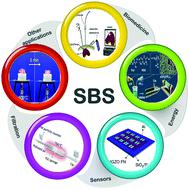当前位置:
X-MOL 学术
›
Mater. Horiz.
›
论文详情
Our official English website, www.x-mol.net, welcomes your
feedback! (Note: you will need to create a separate account there.)
Recent progress and challenges in solution blow spinning
Materials Horizons ( IF 12.2 ) Pub Date : 2020-10-06 , DOI: 10.1039/d0mh01096k Yuan Gao 1 , Jun Zhang , Ying Su , Hang Wang , Xiao-Xiong Wang , Lin-Peng Huang , Miao Yu , Seeram Ramakrishna , Yun-Ze Long
Materials Horizons ( IF 12.2 ) Pub Date : 2020-10-06 , DOI: 10.1039/d0mh01096k Yuan Gao 1 , Jun Zhang , Ying Su , Hang Wang , Xiao-Xiong Wang , Lin-Peng Huang , Miao Yu , Seeram Ramakrishna , Yun-Ze Long
Affiliation

|
In the past 30 years, researchers have worked towards reducing the size of ordinary three-dimensional (3D) materials into 1D or 2D materials in order to obtain new properties and applications of these low-dimensional systems. Among them, functional nanofibers with large surface area and high porosity have been widely studied and paid attention to. Because of the interesting properties of nanofibers, they find extensive application in filtration, wound dressings, composites, sensors, capacitors, nanogenerators, etc. Recently, a variety of nanofiber preparation methods such as melt blowing, electrospinning (e-spinning), centrifugal spinning and solution blow spinning (SBS) have been proposed. This paper includes a brief review of the fundamental principles of the preparation of nanofibers for solution jet spinning, the influence of experimental parameters, and the properties and potential applications of the solution-blown fibers. And the industrialization and challenges of SBS are also included.
中文翻译:

溶液吹纺的最新进展和挑战
在过去的 30 年中,研究人员一直致力于将普通三维 (3D) 材料的尺寸缩小为 1D 或 2D 材料,以获得这些低维系统的新特性和应用。其中,具有大表面积和高孔隙率的功能性纳米纤维已被广泛研究和关注。由于纳米纤维的有趣特性,它们在过滤、伤口敷料、复合材料、传感器、电容器、纳米发电机等方面得到了广泛的应用。最近,人们提出了多种纳米纤维的制备方法,如熔喷法、静电纺丝法(e-spinning)、离心纺丝法和溶液吹丝法(SBS)。本文简要回顾了用于溶液喷射纺丝的纳米纤维制备的基本原理、实验参数的影响以及溶液吹制纤维的性能和潜在应用。而SBS的产业化和挑战也包括在内。
更新日期:2020-11-27
中文翻译:

溶液吹纺的最新进展和挑战
在过去的 30 年中,研究人员一直致力于将普通三维 (3D) 材料的尺寸缩小为 1D 或 2D 材料,以获得这些低维系统的新特性和应用。其中,具有大表面积和高孔隙率的功能性纳米纤维已被广泛研究和关注。由于纳米纤维的有趣特性,它们在过滤、伤口敷料、复合材料、传感器、电容器、纳米发电机等方面得到了广泛的应用。最近,人们提出了多种纳米纤维的制备方法,如熔喷法、静电纺丝法(e-spinning)、离心纺丝法和溶液吹丝法(SBS)。本文简要回顾了用于溶液喷射纺丝的纳米纤维制备的基本原理、实验参数的影响以及溶液吹制纤维的性能和潜在应用。而SBS的产业化和挑战也包括在内。











































 京公网安备 11010802027423号
京公网安备 11010802027423号